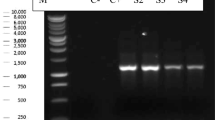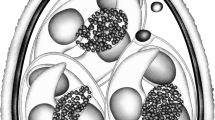Abstract
This study i dentifies four Eimeria spp. recorded from fecal samples of migratory whooper swans (Cygnus cygnus) in Sanmenxia Swan Lake National Urban Wetland Park in Sanmenxia city in the middle reaches of the Yellow River, China. Eimeria hermani, Eimeria nocens, Eimeria stigmosa, and Eimeria magnalabia were compatible in all characteristic features with their respective original descriptions. In addition to the preliminary morphological identification, this study provides a preliminary genotypic identification of these four Eimeria spp. via sequencing of the 18S rRNA, 28S rRNA, and COI gene loci that are suitable for the genotypic differentiation of these coccidia. This is the first report of molecular data for the four Eimeria spp. in migratory whooper swans. Finally, this study discusses the environmental risks of these coccidia for migratory whooper swans in Sanmenxia Swan Lake National Urban Wetland Park.




Similar content being viewed by others
Data availability
All of the data generated and analyzed during this study are included in this published manuscript. The nucleotide sequences for the 18S rRNA, 28S rRNA, and COI loci obtained in this study have been deposited in GenBank, including 18S rRNA (GenBank accession numbers: MW775019–MW775022), 28S rRNA (GenBank accession numbers: MW775030–MW775033), and COI (GenBank accession numbers: MW775674–MW775677).
References
Arnastauskietn T (1967) On the domestic geese coccidia in the Lithuanian SSR (In Russian.). Acta Parasitol 7:5–13
Bertolino S, Wauters LA, Bruyn LD, Canestri-Trotti G (2003) Prevalence of coccidia parasites (protozoa) in red squirrels (sciurus vulgaris): effects of host phenotype and environmental factors. Oecologia 137(2):286–295. https://doi.org/10.1007/s00442-003-1345-x
Christiansen M (1952) Nyrecoccidiose hos vildtlevende andelfugle (Anseriformes). Veterinaermed 4:1173–1191
Craig BH, Pilkington JG, Kruuk LEB, Pemberton JM (2007) Epidemiology of parasitic protozoan infections in soay sheep (ovis aries l.) on st kilda. Parasitol 134(Pt1):9–21. https://doi.org/10.1017/S0031182006001144
Davies SFM (1957) An outbreak of duck coccidiosis in Britain. Vet Rec 69:1051–1052
Dubey JP, Pande BP (1963) A preliminary note on Eimeria battakhi n. sp. (Protozoa: Eimeriidae) from domestic duck (Anas platyrhynchos domesticus). Curr Sci 7:329–330
Fain MG, Krajewski C, Houde P (2007) Phylogeny of “core Gruiformes” (Aves: Grues) and resolution of the Limpkin-Sungrebe problem. Mol Phylogenet Evol 43(2):515–529. https://doi.org/10.1016/j.ympev.2007.02.015
Farr MM (1953) Three new species of coccidia from the Canada goose (Branta canadensis). J Wash Acad 43:336–340
Farr MM (1954) Renal coccidiosis of Canada geese. J Parasitol 40:46
Farr MM (1963) Two new species of coccidia Eimeria crassa and E. pulchella (Sporozoa, Eimeriidae) from the Canada goose, Branta canadensis (L). Proc Helminthol Soc Wash 30:155–157
Farr MM (1965) Coccidiosis of the lesser scaup duck, Aythya of Jinis (Eyton, 1938) with a description of a new species, Eimeria aythyae. Proc Helminthol Soc Wash 32:236–238
Fuller CA (1996) (1996) Population dynamics of two species of Eimeria (Apicomplexa: Eimeriidae) in deer mice (Peromyscus maniculatus): biotic and abiotic factors. J Parasitol 82(2):220–225. https://doi.org/10.2307/3284150
Gajadhar AA, Wobeser GA, Stockdale PHG (1983a) Coccidia of domestic and wild waterfowl (Anseriformes). Can J Zoolo 61(1):1–24
Gajadhar AA, Cawthorn RJ, Wobeser GA, Stockdale PHG (1983b) Prevalence of renal coccidia in wild waterfowl in Saskatchewan. Can J Zool 61(263):1–2633
Golemanskvy G (1961) Espéces et biologie des coccidies des oiseaux en Bulgarie. III. Coccidies des oies (Anser anser anser). (In Bulgarian, French summary.). God Sofii Univ Biol Geol Geogr Fak Kniga I Biologiy a (Zoologiya) 56:89–104
Golemansky VG, Kyulazhieva DK (1981) New data on the coccidium fauna (Sprozoa, Coccidia) of wild and economically valuable birds in Bulgaria (In Bulgarian). Acta Zool Bulg 18:15–22
Grafner G, Graubmann HD, Berke P (1965) Dunndarm kokzidiose bei Hausenten, verursacht durch eine neue Kokzidienart, Eimeria danailovi n. sp. Mh Vet Med Nachr 20:141–143
Greinere C, Forrestejr DJ, Carpenter W, Yparragutrre DR (1981) Coccidia of Aleutian Canada geese. J Wildl Dis 17:365–370
Hill NJ, Deane EM, Power ML (2008) Prevalence and genetic characterization of Cryptosporidium isolates from common brushtail possums (Trichosurus vulpecula) adapted to urban settings. Appl Environ Microbiol 74(17):5549–5555. https://doi.org/10.1128/aem.00809-08
Hanson HC, Levine ND, Ivens V (1957) Coccidia (Protozoa: Eimeriidae) of North American wild geese and swans. Can J Zool 35:715–733
Klimeš B (1963) Coccidia of the domestic goose (Anser dom.). Zentralbl Veterinaermed Reihe B 10:427–448
Kotlán (1933) Zur Kenntnis der Kokzidiose des Wassergefliigels. Die Kokzidiose der Hausgans. Zentralbl. Bakteriol. Parasitenkd. Infektionskr. Hyg Abt 1: Orig Reihe A 129: 11-21
Levine ND (1988) The protozoan phylum Aplicomplexa Volume II. CRC Press LLC 203–357
Levine ND (1951) Tyzzeria and Eimeria from the Canada goose. Proc Am Soc Protozool 2:17
Li GQ, Siao XM, Zhou RQ, Li WH, Wadeh H (2007) Molecular characterization of Cyclospora-like organism from dairy cattle. Parasitol Res 100(5):955–961. https://doi.org/10.1007/s00436-006-0380-z
Li SH, Meng WY, Liu DP, Yang QQ, Chen LX, Dai Q, Ma T, Gao RY, Ru WD, Li YF, Yu PB, Lu J, Zhang GG, Tian HY, Chai HL, Li YB (2018) Migratory whooper swans Cygnus transmit H5N1 virus between China and Mongolia: combination evidence from satellite tracking and phylogenetics analysis. Sci Rep 8:7049–7057. https://doi.org/10.1038/s41598-018-25291-1
Liu G, Li Q, Wang C, Xu CL (2019) The complete mitochondrial genome of Eimeria anseris from the wintering greater white-fronted goose in Shengjin Lake, China, and phylogenetic relationships among Eimeria species. Parasitol Res 118(4):1299–1306. https://doi.org/10.1007/s00436-019-06252-7
Liu J, Xiao H, Lei F, Zhu Q, Qin K, Zhang XW, Zhang XL, Zhao D, Wang G, Feng Y, Ma J, Liu W, Wang J, Gao GF (2005) Highly pathogenic H5N1 influenza virus infection in migratory birds. Sci 309:1206–1207. https://doi.org/10.1126/science
Lu G (2002) Species survey of swan coccidia. Anim Sci Vet Med 1:42–43
Musaev MA, Surkova AM, Jelchiev JA, Alieva FK (1966) New kind of coccidia from the genl Eimeria from the domestic duck (Anas domestica). (In Russian.) Acad Sci Azerbaidj SSR Ser Biol Sci (3) 34–36
Nation PN, Wobeser G (1977) Renal coccidiosis in wild ducks in Saskatchewan. J Wildlife Dis 13(4):370–375
Neischulz O (1947) Eine neue Kokzidienart bei der Hausgans. Zentralbl Bakteriol Parasitenkd Infektionskr 1:152–174
Ogedengbe ME, Ogedengbe JD, Whale JC, Elliot K, Juárez-Estrada MA, Barta JR (2016) Molecular phylogenetic analyses of tissue coccidia (sarcocystidae; apicomplexa) based on nuclear 18s rDNA and mitochondrial COI sequences confirms the paraphyly of the genus hammondia. Parasitol 14:271–278. https://doi.org/10.1017/pao.2015.7
Oksanen A (1994) Mortality associated with renal coccidiosis in juvenile wild greylag geese (Anser anser). J Wildlife Dis 30(4):554
Railliet A, Lucet A (1890) Une nouvelle maladie parasitaire de l’oie domestique, determin Cepar des coccidies. CR Seances Sci Soc Biol Paris 42:292–294
Ryley JF, Meade R, Hazelhurst J, Robinson ET (1976) Methods in coccidiosis research: separation of oocysts from faeces. Parasitol 73(3):311–326
Ryley NG, Ryley JF (1978) Effects of saturated sodium chloride solution on coccidial oocysts. Parasitol 77(1):33–39
Rysavý B, Cerná Z (1988) First record of Eimeria christianseni Waldén, 1961 in swans in Czechoslovakia. Folia Parasit 35(3):280
Scholtysece K (1955) Eimeria anatis n sp., ein neues Coccid aus der Stockente (Anas plaryrhynchos). Arch Protistenkd 100(43):1–434
Skene RC, Remmler O, Fernando MA (1981) Coccidia of Canada geese (Branta canadensis) at Kortright Waterfowl Park, Guelph, Ontario, Canada with description of Isospora anseris n. sp. Can J Zool 59:493–497
Svanbaev SK, Rakhmatullina NK (1967) New kind of coccidia of wild ducks. (In Russian). Farm News Sci (Alma-Ata) 10:46–52
Tong Z, Yang Q (1990) Study on the relationship between chicken coccidia oocyst culture and oxygen content in culture medium. Shanghai J Anim Husbandry Vet Medicin 2:41–43
Tyzzer EE (1929) Coccidiosis in gallinaceous birds. Am J Hyg 10:271–378
Waldén W (1961) Observations on renal coccidia in Swedish anseri form birds, with notes concerning two new species, Eimeria boschadis and Eimeria christianseni (Sporozoa: Telosporidia). Arch Zool 15:97–104
Yang RC, Brice B, Ryan U (2014) Isospora anthochaerae n. sp. (Apicomplexa: Eimeriidae) from a Red wattlebird (Anthochaera carunculata) (Passeriformes: Meliphagidae) in Western Australia. Exp Parasitol 140(1):1–7. https://doi.org/10.1016/j.exppara.2014.02.011
Yuan L, Li XM, Yu HX, Guo LB, Zhang TZ, Gao QJ, Zeng DH (1997) The status and conservation of whooper swans (Cygnus cygnus) in China. J Forestry Res 4:235–239. https://doi.org/10.1007/BF02875012
Zhang J (2012) Study on the wintering ecology of whooper swans in the Sanmenxia reservoir area of the Yellow River. Henan Agricultural University, pp 10–33
Zhang GG, Chen LX, Li SH, Gao RY, Ru WD, Liu DP, Sun MH, Hou YQ, Jun LU (2016) The current status of wintering population of whooper swan (cygnus cygnus) at Sanmenxia reservoir region. China Chinese J Zool 51(02):190–197
Zhu S (2015) Cloning and phylogenetic analysis of 18S and ITS rDNA sequences of four goose coccidia. Yangzhou University, pp 30–48
Acknowledgements
We thank Let Pub (www.letpub.com) for its linguistic assistance during the preparation of this manuscript.
Funding
This research was funded by the National Natural Science Foundation of China (U1904203) and the Leading talents of the Thousand Talents Program of Central China (19CZ0122). The sponsors played no role in study design, in the collection, analysis, or interpretation of the data, in writing the report, or in the decision to submit the article for publication.
Author information
Authors and Affiliations
Contributions
LZ contributed to the conception and design of the experiments. KZ and GL performed the experiments. JL, ZQ, and YW helped in interpretation of data. YZ, RD, and FL collected fecal samples. JL interpreted the results and drafted the manuscript. All of the authors read and approved the final version of the manuscript.
Corresponding author
Ethics declarations
Ethics approval
This study was conducted according to the Regulations for the Implementation of the People’s Republic of China on the Protection of Terrestrial Wildlife and Law of the People’s Republic of China on the Protection of Wildlife. The research protocol was reviewed and approved by the Research Ethics Committee of Henan Agricultural University. No migratory whooper swan specimens were harmed in our study.
Consent to participate
Not applicable.
Consent for publication
Not applicable.
Conflict of interest
The authors declare no competing interests.
Additional information
Handling Editor: Una Ryan
Publisher's note
Springer Nature remains neutral with regard to jurisdictional claims in published maps and institutional affiliations.
Rights and permissions
Springer Nature or its licensor holds exclusive rights to this article under a publishing agreement with the author(s) or other rightsholder(s); author self-archiving of the accepted manuscript version of this article is solely governed by the terms of such publishing agreement and applicable law.
About this article
Cite this article
Zhang, K., Liang, G., Lang, J. et al. Eimeria spp. (Eimeriidae) in the migratory whooper swan (Cygnus cygnus) Linnaeus, 1758 (Anatidae) from Sanmenxia Swan Lake National Urban Wetland Park in the middle reaches of the Yellow River in China. Parasitol Res 121, 2967–2977 (2022). https://doi.org/10.1007/s00436-022-07629-x
Received:
Accepted:
Published:
Issue Date:
DOI: https://doi.org/10.1007/s00436-022-07629-x




